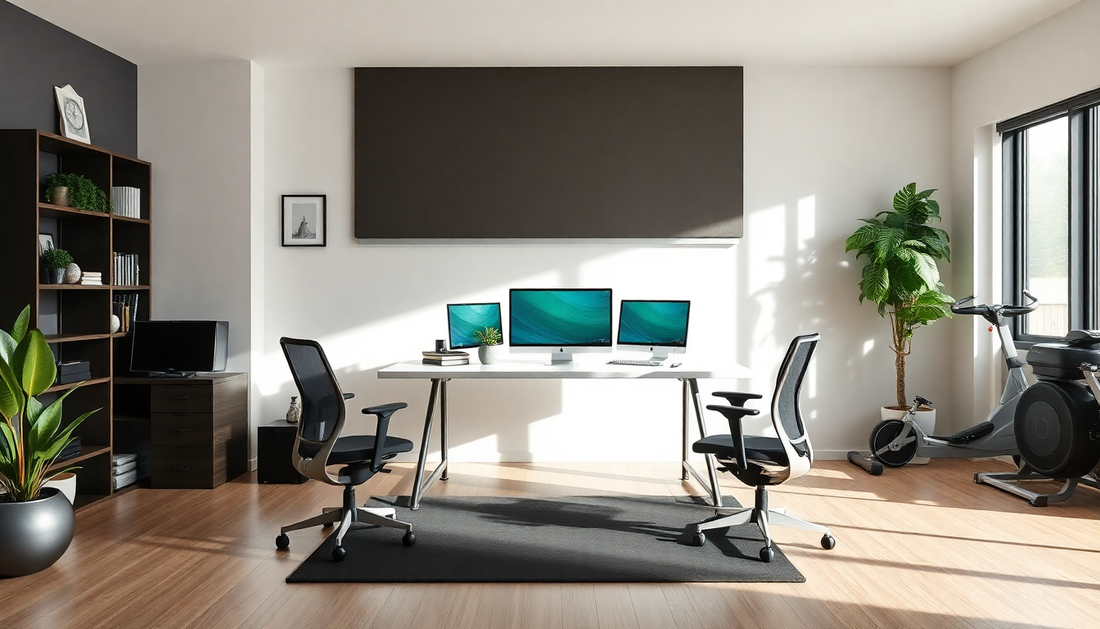Innovative Home Office and Fitness Space Optimization for 2025: Designing for Productivity and Wellness Integration

Introduction
As we embrace 2025, the need for a harmonious blend of productivity and wellness in our home environments has never been more critical. With the rise of remote work and a growing emphasis on health, optimizing your home office and fitness space is essential. This article explores innovative strategies to create spaces that foster both productivity and well-being, allowing you to thrive in your personal and professional life.
The Importance of Space Optimization
In the modern age, our physical spaces significantly influence our mental health and productivity levels. Here are some reasons why optimizing your home office and fitness space is crucial:
- Enhanced Focus: A well-organized workspace minimizes distractions, allowing for greater concentration.
- Improved Health: Integrating fitness into your home environment promotes physical activity, reducing sedentary behavior.
- Work-Life Balance: Designing distinct areas for work and exercise helps maintain boundaries between professional and personal life.
- Increased Creativity: A thoughtfully designed environment can inspire creativity and innovation, leading to better problem-solving.
- Emotional Well-Being: Spaces that promote wellness can reduce stress levels and enhance overall happiness.
Innovative Design Tips for Your Home Office
Creating a productive home office involves thoughtful design elements that cater to your work style and preferences. Here are some innovative tips:
- Ergonomic Furniture: Invest in adjustable desks and ergonomic chairs that support posture and reduce strain during long working hours. Consider standing desks or treadmill desks to promote movement.
- Smart Technology: Utilize smart gadgets like voice-activated assistants and automated lighting to streamline tasks and enhance efficiency. Incorporate screens that minimize blue light exposure to protect your eyes.
- Flexible Layout: Design your office to accommodate different work modes, such as collaborative spaces for meetings and quiet zones for focused tasks. Use modular furniture that can be rearranged as needed.
- Natural Light: Maximize natural light with large windows or skylights to boost mood and energy levels while reducing eye strain. If natural light is limited, consider full-spectrum bulbs that simulate daylight.
- Personalization: Add personal touches such as artwork, photographs, or plants to create a space that feels uniquely yours and inspires motivation.
- Noise Control: Use soundproofing materials or white noise machines to minimize distractions from outside sources, helping to maintain focus during work hours.
- Decluttering Strategies: Implement organizational tools like shelves, file cabinets, and cable management solutions to keep your workspace tidy and efficient.
Integrating Fitness into Your Home Space
Incorporating fitness into your home design encourages a more active lifestyle. Here are some strategies to consider:
- Multi-Functional Areas: Create spaces that serve dual purposes, such as a guest room that also features a compact workout area. Consider foldable or convertible fitness equipment that can be easily stored away.
- Fitness Zones: Designate specific areas for different types of exercise, such as yoga, strength training, or cardio, to promote variety and engagement. Use colorful mats and equipment to make these areas visually appealing.
- Incorporate Greenery: Add indoor plants to enhance air quality and create a calming atmosphere, making workouts more enjoyable. Plants like snake plants and pothos are easy to care for and thrive indoors.
- Accessible Equipment: Choose compact and versatile fitness equipment that can be easily stored or integrated into your home decor. Items like resistance bands, dumbbells, and kettlebells can be stylishly displayed.
- Outdoor Integration: If possible, create a seamless connection between your indoor and outdoor spaces. Use patios or balconies for outdoor workouts or relaxation areas.
- Incorporate Technology: Use fitness apps or smart devices that track your workouts and progress, helping to keep you motivated and accountable.
Creating a Wellness-Focused Environment
To foster overall well-being, consider these additional elements:
- Mindfulness Zones: Dedicate a space for relaxation or meditation, complete with comfortable seating, calming decor, and perhaps a small water feature for tranquility.
- Air Quality: Invest in air purifiers and optimize ventilation to ensure a healthy living environment. Regularly open windows to let in fresh air and prevent stuffiness.
- Sound Control: Use soundproof materials or white noise machines to minimize distractions and create a peaceful atmosphere. Soft background music can also enhance focus and productivity.
- Color Psychology: Choose colors that promote productivity and calmness in your workspace. Soft blues and greens can create a serene atmosphere, while pops of bright colors can stimulate creativity.
- Engaging Lighting: Implement layered lighting solutions, including ambient, task, and accent lighting, to create a versatile and inviting space. Adjustable lighting can help set the mood for different activities.
- Regular Breaks: Design your space to encourage regular movement and breaks. Consider a timer or reminder system to prompt you to stand up, stretch, or take a short walk.
Future Trends in Home Office and Fitness Design
As we look ahead, several trends are emerging that will shape how we design our home office and fitness spaces in the coming years:
- Biophilic Design: The integration of natural elements into our environments is gaining popularity. This includes using natural materials, maximizing views of nature, and incorporating plants into interiors.
- Smart Home Integration: The rise of the Internet of Things (IoT) will continue to influence home design, allowing for seamless control of lighting, temperature, and fitness equipment through smart devices.
- Sustainable Practices: Eco-friendly materials and energy-efficient appliances will become increasingly important as homeowners seek to reduce their carbon footprint.
- Virtual Reality Fitness: The use of virtual reality in fitness routines is on the rise, providing immersive experiences that can make workouts more engaging and effective.
- Hybrid Workspaces: As remote work becomes more common, the design of home offices will evolve to accommodate both work and leisure, making flexibility a key feature.
Conclusion
As we move into 2025, the convergence of home office and fitness spaces is more than just a trend; it’s a necessity for those seeking to balance productivity with well-being. By implementing innovative design strategies, you can create an environment that not only enhances your work efficiency but also nurtures your physical and mental health. Embrace these changes to foster a more fulfilling and productive lifestyle, ensuring that your home remains a sanctuary for both work and wellness.
